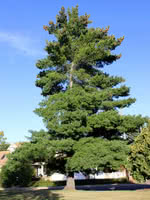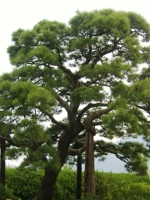Mon-Fri 9am - 5pm Mountain time
Eastern White Pine vs Japanese Black Pine
Pinus strobus
Pinus thunbergii
NOT AVAILABLE THIS SEASON - MIGHT RETURN
NOT AVAILABLE THIS SEASON - MIGHT RETURN
Eastern White Pine is a large pine native to eastern North America. It is the provincial tree of Ontario.
This long-lived, rapid growing giant is known for its long, flexible blue-green needles. Eastern White Pine is low-maintenance and makes a beautiful ornamental tree suitable for large properties and parks.
Japanese Black Pine is known for its unique and irregular growth habit, making it a striking landscape addition. It typically does not grow with a central leader. This causes it to form a flat-top, classic bonsai-like shape when mature. When it has a central leader, it will grow with a twisted trunk. Another striking feature is the white apical buds which contrast with the surrounding green needles.
The Japanese Black Pine is an excellent candidate for a bonsai tree and is frequently used by the bonsai community. It is found along the Japanese coast and is salt tolerant.

